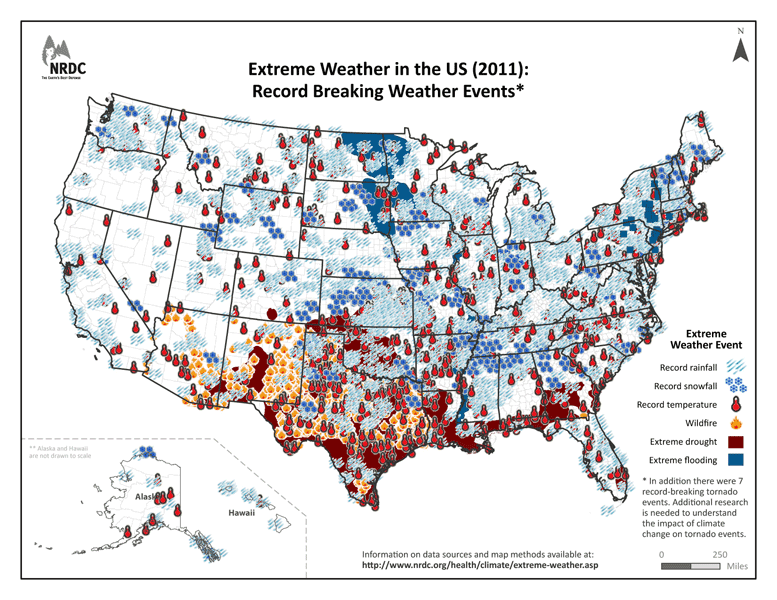Extreme Weather
Extreme Weather
Scientists predict a major upturn in the incidence of extreme weather events due to the changing climate. According to the National Wildlife Foundation, the maximum wind speeds of tropical storms/hurricanes are expected to rise 11% by the end of the 21st century. Total rainfall is also expected to increase by over 30% and cause an even greater percentage rise in flood-related property damage, municipal water contamination and human casualties.
While some regions report higher levels of precipitation, others communities are already experiencing uncharacteristic dry spells. Drought like this can contribute to declining crop yield, spread of uncontrolled wildfires and the destruction of wildlife habitat. As the NWF notes, “global warming suggests more is yet to come ― continued climate changes will potentially cause both more extremely dry periods and more heavy rainfall events.” When it comes to rising sea levels resulting from these changing weather patterns, a primary concern consideration for both wildlife and people that rising sea levels could potentially taint subterranean freshwater reserves.
Extreme Weather in the U.S. (2011)

Image via the National Resource Defense Council. Record breaking extreme weather events including record rainfall, snowfall, temperatures, wildfire, drought and flooding are becoming more common throughout the U.S.
Extreme weather patterns carry a wide range of implications regarding human populations. In addition to the high potential for injuries and deaths during hurricanes, floods, and other weather-related disasters, human health risks include:
- Foodborne diseases: Changes to temperature and precipitation cycles have led to significant crop destruction, which in turn has reduced “the availability and nutritional content of food supplies,” according to the NIEHS. Climate change has also caused an influx of aphids and other crop pests, forcing farmers to apply higher concentrations of pesticides, thereby reducing nutrition and increasing the toxicity of crop yields. Spread of the mold that creates aflatoxin (a substance known to cause liver damage) has also been linked to global warming.
- Waterborne diseases: Drought conditions foster the spread of “effluent pathogens,” notes the NIEHS, which can contaminate drinking water reserves. Flooding of wastewater treatment centers and sewers can also taint water supplies reserved for public consumption.
- Winter-related health risks: We’ve discussed some of the health problems associated with extreme heat, but extreme cold has also been linked to various diseases and conditions. According to the NHS Choices, winter health risks include pneumonia, influenza, norovirus, and heart disease.
- Carbon monoxide poisoning: One indirect health effect of climate change is the risk of poisoning from CO-powered generators used after floods, hurricanes, and other natural disasters that cause power outages, says the EPA. Other effects include intestinal diseases, mental health disorders, and other health problems that stem from large-scale public evacuations.
- Limited resources: Water, food, and shelter can quickly become scarce during a natural disaster. In addition to the risk of physical harm, the lack of necessities can lead to starvation, dehydration, and malnutrition, as well as interrupted health care services.
The human and financial tolls of natural disasters caused or exacerbated by climate change can be difficult to calculate. The International Disaster Database (EM-DAT) notes that approximately 12,400 U.S. citizens lost their lives between 1980 and 2010 due to natural catastrophes. Additionally, more than 26 million were affected by disasters. These events collectively caused more than $544 billion in damage costs, or roughly $17.5 billion per year during the 30-year period.
